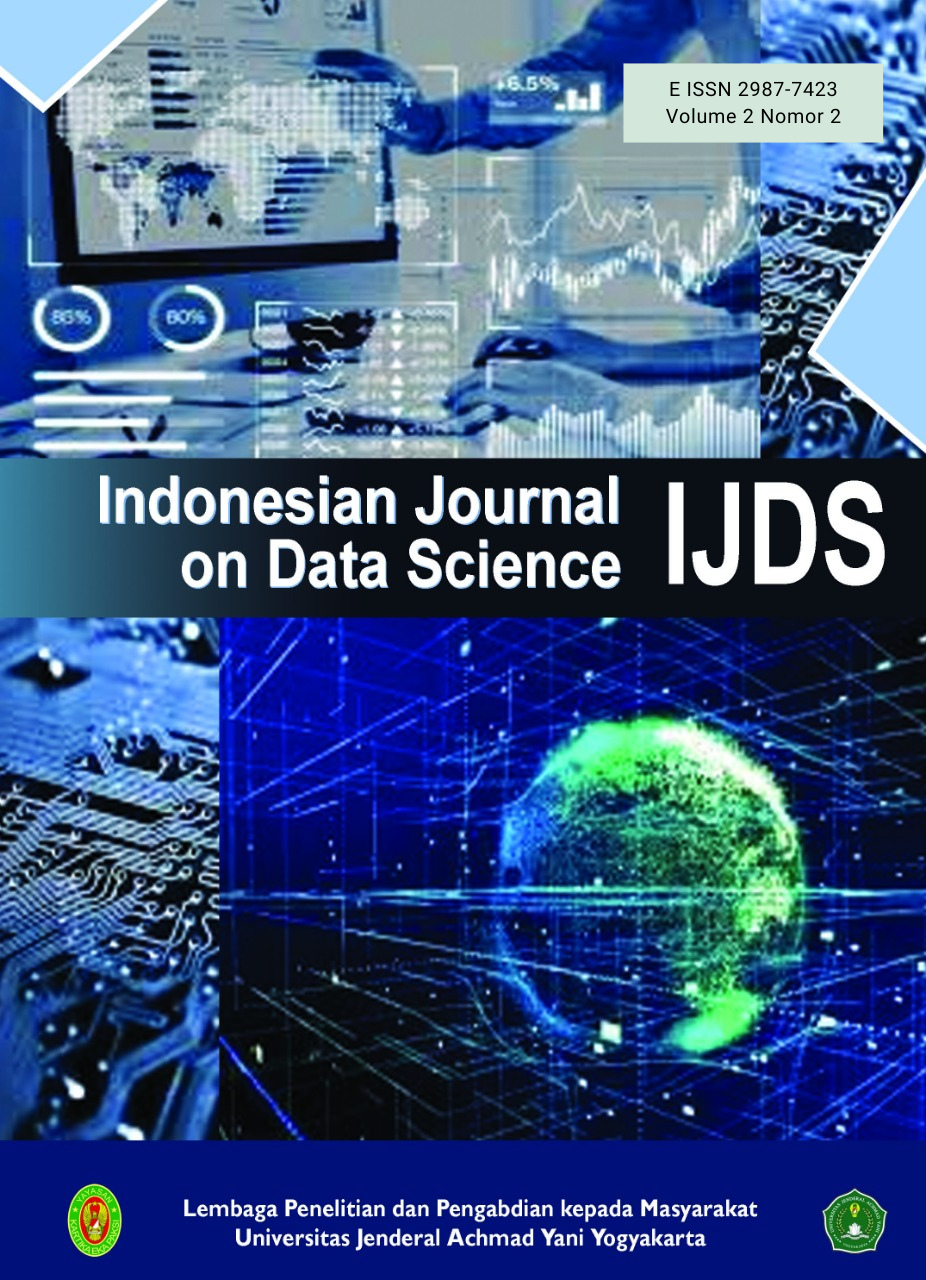Sistem Chabot Layanan Informasi Mahasiswa Menggunakan Algoritma Long Short-Term Memory
DOI:
https://doi.org/10.30989/ijds.v2i2.1489Kata Kunci:
Chatbot, Information Service, Long Short-Term Memory, Machine Learning Development Cycle, Real-time Information, Student ServicesAbstrak
In the era of globalization and rapid information flow, the demand for efficient and accurate information, especially within academic institutions, is rising. Students often face challenges in accessing educational resources and real-time information, particularly outside official working hours. Existing online information services have limitations in providing continuous access. This research focuses on developing and evaluating a student information service chatbot system at Universitas Jenderal Achmad Yani Yogyakarta (UNJAYA) using the Long Short-Term Memory (LSTM) algorithm. The primary objective is to create a system that delivers real-time, accurate, and efficient information services to students. The Machine Learning Development Cycle (MLDC) is employed in the model development process, including stages such as data collection, processing, model training, evaluation, and implementation. The system's performance is tested using a questionnaire distributed to students, with responses measured on a Likert scale. The results demonstrate a chatbot with a 97.76% accuracy rate, 98.34% precision, and 97.76% recall. The overall system evaluation yielded an average score of 3.87, categorized as good. This research concludes that the LSTM-based chatbot successfully enhances information services at the Faculty of Engineering and Information Technology, providing an innovative solution to meet student needs in real-time
Referensi
[2] N. H. Capsa, K. T. Barlian, Z. D. Amandari, and P. Rachmadi, “Analisa Kebutuhan Chatbot Di Layanan FTI Perbanas Jakarta,” in Prosiding Seminar Nasional, 2023, pp. 197–206.
[3] A. Lubis and I. Sumartono, “Implementasi Layanan Akademik Berbasis Chatbot untuk Meningkatkan Interaksi Mahasiswa,” RESOLUSI: Rekayasa Teknik Informatika dan Informasi, vol. 3, no. 5, pp. 246–252, 2023.
[4] D. G. S. Ruindungan and A. Jacobus, “Chatbot Development for an Interactive Academic Information Services using the Rasa Open Source Framework,” Jurnal Teknik Elektro dan Komputer, vol. 10, no. 1, pp. 61–68, 2021.
[5] B. Luo, R. Y. K. Lau, C. Li, and Y. Si, “A critical review of state?of?the?art chatbot designs and applications,” Wiley Interdiscip Rev Data Min Knowl Discov, vol. 12, no. 1, p. e1434, 2022.
[6] J. Yin, T.-T. Goh, B. Yang, and Y. Xiaobin, “Conversation Technology With Micro-Learning: The Impact of Chatbot-Based Learning on Students’ Learning Motivation and Performance,” Journal of Educational Computing Research, vol. 59, no. 1, pp. 154–177, Mar. 2021, doi: 10.1177/0735633120952067.
[7] L. Fahadra, “Sistem Chatbot Layanan Informasi Tugas Akhir Menggunakan Metode Long Short-Term Memory (LSTM),” Universitas Islam Sultan Agung, 2023.
[8] P. B. Wintoro, H. Hermawan, M. A. Muda, and Y. Mulyani, “Implementasi Long Short-Term Memory pada Chatbot Informasi Akademik Teknik Informatika Unila,” Expert J. Manaj. Sist. Inf. dan Teknol, vol. 12, no. 1, p. 68, 2022.
[9] M. I. T. Khaqiqi, N. H. Harani, and C. Prianto, “Performance Analysis and Development of QnA Chatbot Model Using LSTM in Answering Questions,” Indonesian Journal of Computer Science, vol. 12, no. 3, 2023.
[10] M. R. Jhaerol and S. Sudianto, “Implementation of chatbot for merdeka belajar kampus merdeka program using long short-term memory,” Jurnal Nasional Pendidikan Teknik Informatika: Janapati, vol. 12, no. 2, 2023.
[11] D. Khurana, A. Koli, K. Khatter, and S. Singh, “Natural language processing: state of the art, current trends and challenges,” Multimed Tools Appl, vol. 82, no. 3, pp. 3713–3744, 2023, doi: 10.1007/s11042-022-13428-4.
[12] M. Al-Amin et al., “History of generative Artificial Intelligence (AI) chatbots: past, present, and future development,” arXiv preprint arXiv:2402.05122, 2024.
[13] A. Azni, “Implementasi Natural Language Processing Pada Sistem Chatbot Informasi Saham dengan Algoritma Long Short-Term Memory (Lstm) dan Fuzzy String Matching,” Doctoral Dissertation, Universitas Sumatera Utara, 2021.
[14] P. W. Cahyo and U. S. Aesyi, “Perbandingan LSTM dengan Support Vector Machine dan Multinomial Na ve Bayes pada Klasifikasi Kategori Hoax,” Jurnal Transformatika, vol. 20, no. 2, pp. 23–29, 2023.
[15] J. W. &. Sons, Keras to Kubernetes®: The Journey of a Machine Learning Model to Production, New York: Inc. 2019.
[16] Streamlit, “Streamlit documentation.” Accessed: Mar. 21, 2024. [Online]. Available: https://docs.streamlit.io/
[17] P. B. A. A. Putra, “Pengembangan aplikasi kuesioner survey berbasis web menggunakan skala likert dan guttman,” Jurnal Sains dan Informatika p-ISSN, vol. 2460, p. 173X, 2019.
[18] N. M. D. Parwati, I. W. Tuwi, and N. L. R. Yusmarisa, “ANALISIS SISTEM INFORMASI AKUNTANSI DALAM PENYUSUNAN LAPORAN KEUANGAN DI HOTEL XYZ DENGAN METODE PIECES,” Neraca: Jurnal Ekonomi, Manajemen dan Akuntansi, vol. 2, no. 8, pp. 277–283, 2024.
Unduhan
Diterbitkan
Terbitan
Bagian
Citation Check
Lisensi
Hak Cipta (c) 2025 Dewi Arumsari, kharisma, Ulfi Saidata Aesyi

Artikel ini berlisensiCreative Commons Attribution-ShareAlike 4.0 International License.
Indonesian Journal On Data Science allows readers to read, download, copy, distribute, print, search, or link to its articles' full texts and allows readers to use them for any other lawful purpose. The journal allows the author(s) to hold the copyright without restrictions. Finally, the journal allows the author(s) to retain publishing rights without restrictions
- Authors are allowed to archive their submitted articles in an open access repository
- Authors are allowed to archive the final published article in an open access repository with an acknowledgment of its initial publication in this journal

This work is licensed under a Creative Commons Attribution-ShareAlike 4.0 Generic License.



